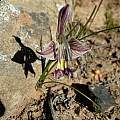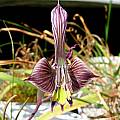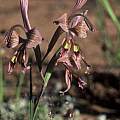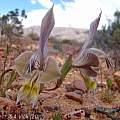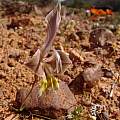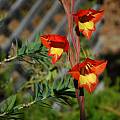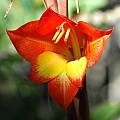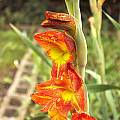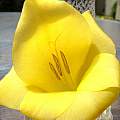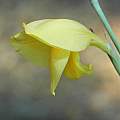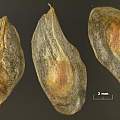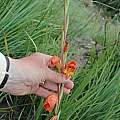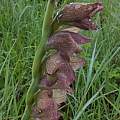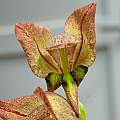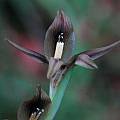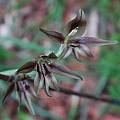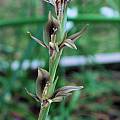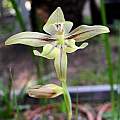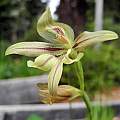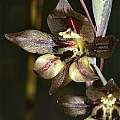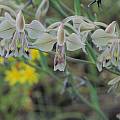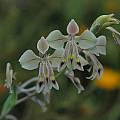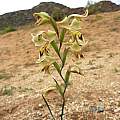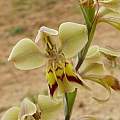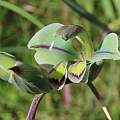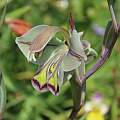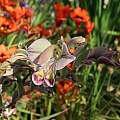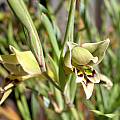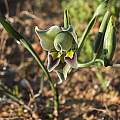This page lists the Gladiolus which feature what most people would call the non-colors when considering flowers. Greens and browns may be a sign for fly pollination if being the main color form.
Gladiolus ceresianus L.Bolus grows on stony slopes and flats in clay soil from southern Namaqualand to the western Karoo and in the Roggeveld and Bokkeveld Plateau. It is a small plant, up to 10 cm tall with linear leaves with four longitudinal grooves and one to four flowers in a inclined spike that are brown to purple with dark veining. Flowers are pleasantly scented. This species flowers from August to October in the wild. Flowers are similar to Gladiolus uysiae, but that species has flat leaves. It is also very similar to Gladiolus virescens, but has dark, hard scales around the corms. Photo 1 from Cameron McMaster taken on the Matjiesfontein Sutherland road in the Roggeveld, photo 2 from Alan Horstmann, and photo 3 from Rod Saunders. The last two photos from the book Plants of the Klein Karoo courtesy of Jan and Anne Lise Schutte-Vlok.
Gladiolus dalenii Van Geel is a widespread and common species found not only in Southern Africa, but also in other parts of tropical Africa. It has been known by a number of names over the years; there have been 27 synonyms for the tropical Africa and Madagascar forms and 14 more for the southern African forms. The main synonyms for the southern Africa collections have been Gladiolus natalensis and Gladiolus psittacinus. This species blooms at different times of the year depending on the location, but there are probably flowers every month of the year somewhere in its native habitats. Flowers are either red to orange with yellow markings on the lower half of the three lower tepals or yellow to greenish with red to brown streaks on the upper tepals. Although it favors moist habitats and is often found in grassland, it can also be found in dry habitats with only a short wet season. The ones I grew in Northern California lived for a number of years in the garden, dormant during our wet winters, appearing late spring and surviving through the dry summer and blooming in the fall. The flowering stalks were very tall with a number of flowers. Photos 1-2 of those plants were taken by Mary Sue Ittner. Photo 3 by Cameron McMaster shows plants in cultivation. Photos 4-5 by Mary Hunter and Mary Sue Ittner show the first bloom from seed of a yellow form of ssp. dalenii, once known as Gladiolus primulinus blooming in late summer in Northern California. The last photo by David Pilling shows seed.
The first photo below from Cameron McMaster shows flowering plants in habitat in the Eastern Cape. The second is another habitat shot taken near Balloch in the Eastern Cape, January 2010 by Bob Rutemoeller. Photo Nr. 3 from Rachel Saunders shows an unusual color form and was taken in northern KwaZulu-Natal in January 2015. The last photo shows the beautiful detail on likely the same color form, as the seeds were obtained from Silverhill, flowering the second year from seed for Martin Bohnet.
Gladiolus hyalinus Jacq. is a wide spread species in the winter-rainfall region where it is found from Namaqualand to the southwestern Cape and in a couple of places in the southern Cape and the Eastern Cape. In the Cape Flora region it is found in transitional fynbos and in Namaqualand on granite derived sand or clay. It flowers from winter into spring depending on the elevation. Flowers are light to reddish brown on a pale cream background. There are dark spots and streaks on the throat. The first five photos taken by Mary Sue Ittner who grew her plants from seed. Photos 4-5 were taken in a later year of flowers that look very different from the flowers of the one that bloomed in the past. The last photo was taken by Andrew Harvie on the R27, near Nieuwoudtville.
Gladiolus orchidiflorus Andrews is found on clay and sandstone soils from Namibia to Cape Flats and also to Free State and flowers in the spring. It has linear to sword-shaped leaves that are thickened in the midline. Flowers are in a 5 to 12 flowered spike, windowed in profile, greenish to purple with dark purple markings on the lower tepals, and are very fragrant. Photos 1-2 are habitat shots taken in Namaqualand by Bob Rutemoeller and Mary Sue Ittner September 2006. Photos 3-4 were taken near Carolusberg, Namaqualand by Cameron McMaster September 2011.
The photos below were taken by Alan Horstmann.
Gladiolus viridiflorus grows on rocky sandstone slopes in the northwest Cape. The first photo was taken by Sheila Burrow of a plant flowering exactly one year from sowing. The second photo from Rachel Saunders was taken near the Pakhuis Pass. Although it grows in many areas, it is small and difficult to see and not very common.
